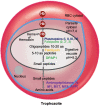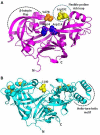Structural Insights Into Key Plasmodium Proteases as Therapeutic Drug Targets
- PMID: 30891019
- PMCID: PMC6411711
- DOI: 10.3389/fmicb.2019.00394
Structural Insights Into Key Plasmodium Proteases as Therapeutic Drug Targets
Abstract
Malaria, caused by protozoan of genus Plasmodium, remains one of the highest mortality infectious diseases. Malaria parasites have a complex life cycle, easily adapt to their host's immune system and have evolved with an arsenal of unique proteases which play crucial roles in proliferation and survival within the host cells. Owing to the existing knowledge of enzymatic mechanisms, 3D structures and active sites of proteases, they have been proven to be opportune for target based drug development. Here, we discuss in depth the crucial roles of essential proteases in Plasmodium life cycle and particularly focus on highlighting the atypical "structural signatures" of key parasite proteases which have been exploited for drug development. These features, on one hand aid parasites pathogenicity while on the other hand could be effective in designing targeted and very specific inhibitors for counteracting them. We conclude that Plasmodium proteases are suitable as multistage targets for designing novel drugs with new modes of action to combat malaria.
Keywords: Ca2+-dependent subtilase; aspartyl protease fold; drug targets; malaria; papain-family cysteine proteases; proteases; therapeutics.
Figures






Similar articles
-
Falcipain cysteine proteases of malaria parasites: An update.Biochim Biophys Acta Proteins Proteom. 2020 Mar;1868(3):140362. doi: 10.1016/j.bbapap.2020.140362. Epub 2020 Jan 9. Biochim Biophys Acta Proteins Proteom. 2020. PMID: 31927030 Review.
-
Cysteine proteases of malaria parasites.Int J Parasitol. 2004 Dec;34(13-14):1489-99. doi: 10.1016/j.ijpara.2004.10.003. Int J Parasitol. 2004. PMID: 15582526 Review.
-
Cysteine proteases of malaria parasites: targets for chemotherapy.Curr Pharm Des. 2002;8(18):1659-72. doi: 10.2174/1381612023394197. Curr Pharm Des. 2002. PMID: 12132997 Review.
-
Therapeutic Targeting and Role of Cysteine Proteases in the Life Cycle of Malaria Parasite.Curr Med Chem. 2024 Aug 23. doi: 10.2174/0109298673308069240815072244. Online ahead of print. Curr Med Chem. 2024. PMID: 39185645
-
Falcipains and other cysteine proteases of malaria parasites.Adv Exp Med Biol. 2011;712:30-48. doi: 10.1007/978-1-4419-8414-2_3. Adv Exp Med Biol. 2011. PMID: 21660657 Review.
Cited by
-
A tale of two parasites: a glimpse into the RNA methylome of patient-derived Plasmodium falciparum and Plasmodium vivax isolates.Malar J. 2025 May 2;24(1):139. doi: 10.1186/s12936-025-05376-9. Malar J. 2025. PMID: 40316999 Free PMC article.
-
Arginine substitution by alanine at the P1 position increases the selectivity of CmPI-II, a non-classical Kazal inhibitor.Biochem Biophys Rep. 2021 May 11;26:101008. doi: 10.1016/j.bbrep.2021.101008. eCollection 2021 Jul. Biochem Biophys Rep. 2021. PMID: 34027134 Free PMC article.
-
Repurposing the McoTI-II Rigid Molecular Scaffold in to Inhibitor of 'Papain Superfamily' Cysteine Proteases.Pharmaceuticals (Basel). 2020 Dec 23;14(1):7. doi: 10.3390/ph14010007. Pharmaceuticals (Basel). 2020. PMID: 33374547 Free PMC article.
-
Biochemical Properties of Two Plasmodium malariae Cysteine Proteases, Malapain-2 and Malapain-4.Microorganisms. 2022 Jan 16;10(1):193. doi: 10.3390/microorganisms10010193. Microorganisms. 2022. PMID: 35056641 Free PMC article.
-
Discovery and Characterization of Potent, Efficacious, Orally Available Antimalarial Plasmepsin X Inhibitors and Preclinical Safety Assessment of UCB7362.J Med Chem. 2022 Oct 27;65(20):14121-14143. doi: 10.1021/acs.jmedchem.2c01336. Epub 2022 Oct 10. J Med Chem. 2022. PMID: 36216349 Free PMC article.
References
Publication types
LinkOut - more resources
Full Text Sources
Miscellaneous

